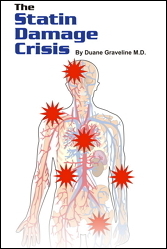Kilmer McCully, M.D. - Cholesterol - Part 1 of 2
 By Kilmer McCully, M.D.
By Kilmer McCully, M.D.
Cholesterol [chole = bile, and stereos = solid, Greek] is a fatlike alcohol occurring in animal fats and oils, especially gallstones, bile, blood, brain, milk, egg yolk, liver, kidney, nerves, atherosclerotic arteries, and adrenal glands.
Cholesterol is a lipid, a substance extractable from tissues by organic solvents like chloroform-methanol. When the lipid fraction is treated with alkali, triglycerides, phospholipids, sphingolipids and lipoproteins are converted to substances soluble in water.
Because of its chemical composition, however, cholesterol remains with the lipid fraction after alkali treatment, hence it is a non-saponifiable lipid. Cholesterol is a fatty alcohol that is a normal constituent of all animal cell membranes and is not present in plant tissues.
In the liver, intestine and other tissues cholesterol is synthesized from acetate in the coenzyme A form, through a complex series of reactions involving several terpene intermediates, as demonstrated by Konrad Bloch and other investigators.
In the mid 19th century the important German pathologist Rudolf Virchow described the process by which arteriosclerosis develops in arteries. His name for the disease was "endoarteritis chronica deformans nodosa."
He described inflammatory changes in arterial intima, fatty infiltration of intima, mucoid degeneration of arterial wall, fibrosis, calcification, and atheroma with crystal deposition. He suggested that altered permeability of arterial intima led to increased filtration of plasma and deposition of plasma fats in association with the degenerative changes of arterial wall. In 1914 Ludwig Aschoff described deposition of cholesterol crystals in aortic atheromas.
Wladimir Sergius Ignatowsky, an obscure medical investigator in St. Petersburg, became interested in the idea that arteriosclerosis in populations in England was related to consumption of meat, eggs and dairy products by the wealthier classes. In 1908 he reported the results of feeding these foods to rabbits, a vegetarian species.
He discovered plaques in the arteries of rabbits resembling the plaques found in human arteries with atherosclerosis, including deposition of lipids and cholesterol crystals. Because of the large amounts of animal protein in the experimental diet, he suggested that the plaques were caused by protein intoxication.
In 1914 another investigator in St. Petersburg, Nicolai Anitschkow, decided to feed purified cholesterol dissolved in plant oils to rabbits, and he discovered deposition of cholesterol in many organs including the arteries of these animals. He suggested that the plaques in Ignatowsky's rabbits were caused by the cholesterol of the animal foods in the experimental diet. These experiments were undoubtedly related to the discovery of cholesterol crystals in human plaques by Aschoff and other investigators.
In America a young investigator in Boston named Harry Newburgh, who was trained in medical research at Massachusetts General Hospital, was recruited by the University of Michigan Medical School in 1919 to become the first full time faculty member in America devoted to research in clinical medicine.
He decided to repeat Ignatowsky's experiments with rabbits using meat powder as a source of protein in the diet from which all fats and cholesterol had been removed by extraction with organic solvents.
He found that plaques developed in the arteries of his rabbits, even though no fats or cholesterol were present in the experimental diet, effectively disproving Anitschkow's suggestion that these substances caused the arterial plaques.
Newburgh then started giving individual amino acids one by one to dogs, rabbits and other animals, looking for evidence of arterial plaques. Although he found no plaques, he discovered toxicity of several amino acids to kidneys, leading to the Newburgh-Marsh diet, an effective treatment for kidney failure in the years before dialysis treatment.
The amino acids methionine and homocysteine had not been discovered when Newburg conducted his experiments, and if they had been available, he would have discovered the ability of these amino acids to cause plaques in animals.
According to Ancel Keys, a professor of physiology and nutrition in Minnesota, the earliest epidemiological investigation relating cholesterol to human atherosclerosis was conducted by the Dutch physician, CD DeLangen, who reported his experience working with patients in Java.
In 1916 DeLangen reported that his patients had low levels of cholesterol in the blood, possibly explaining the rarity of atherosclerosis, phlebothrombosis and gallstones in this Asian population. In contrast, Javanese stewards on Dutch ships in Java, who consumed the rich Dutch diet, had increased levels of cholesterol in their blood, and DeLangen advocated a low cholesterol diet for prevention of atherosclerosis, based on these observations.
Keys later became the leading advocate of what became to be known as the "diet-heart" hypothesis that related dietary consumption of fats and cholesterol to susceptibility to vascular disease, especially coronary heart disease. Keys and his colleagues studied mortality rates from countries around the world, reporting an association with dietary fat available for consumption in the "Seven Countries Study."
However, when similar data from other sources, available to Keys, are considered, the association becomes quite weak. For example, the mortality rate in Finland was almost 7 times higher than in Mexico, although the fat consumption was identical. Subsequently authoritative critical review of the Seven Countries Study by statisticians Smith and Pinckney revealed "a massive set of inconsistencies and contradictions," leading to the conclusion that the "study cannot be taken seriously by the objective and critical scientist."
Kilmer S. McCully, M.D.
Chief, Pathology and Laboratory Medicine Service
West Roxbury Veterans Affairs Medical Center
Kilmer McCully M.D. - Cholesterol - Part 2






